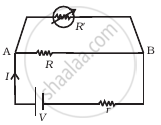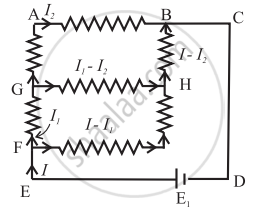Advertisements
Advertisements
प्रश्न
Consider a simple circuit shown in figure ![]() stands for a variable resistance R′. R′ can vary from R0 to infinity. r is internal resistance of the battery (r << R << R0).
stands for a variable resistance R′. R′ can vary from R0 to infinity. r is internal resistance of the battery (r << R << R0).

- Potential drop across AB is nearly constant as R ′ is varied.
- Current through R′ is nearly a constant as R ′ is varied.
- Current I depends sensitively on R′.
- `I ≥ V/(r + R)` always.
पर्याय
a and b
b and c
c and d
a and d
उत्तर
a and d
Explanation:
As r << R << R0 < R' from question, R' > R and R' and R are in parallel combination, so the equivalent resistance will be always less than R. So `I ≥ V/(r + R)` and potential across AB will remain nearly constant.
Important point: In parallel combination of resistances, the equivalent resistance is smaller than smallest resistance present in combination.
APPEARS IN
संबंधित प्रश्न
State the advantages of potentiometer over voltmeter.
SI unit of potential gradient is _______.
(a) V cm
(b) `V/"cm"`
(c) Vm
(d) `V/m`
Would you prefer a voltmeter or a potentiometer to measure the emf of a battery?
How is potential gradient measured? Explain.
Find the equivalent resistance between the terminals of A and B in the network shown in the figure below given that the resistance of each resistor is 10 ohm.

Why is a potentiometer preferred over a voltmeter for measuring emf?
A potentiometer wire is 10 m long and has resistance of 2`Omega`/m. It is connected in series with a battery of e.m.f 3 V and a resistance of 10 `Omega`. The potential gradient along the wire in V/m is ______.
In the potentiometer experiment, cells of e.m.f. E1 and E2 are connected in series (E1 > E2). the balancing length is 64 cm of the wire. If the polarity of E2 is reversed, the balancing length becomes 32 cm. The ratio `E_1/E_2` is ______
The best instrument for accurate measurement of EMF of a cell is ____________.
Three identical cells each of emf 'e' are connected in parallel to form a battery. What is the emf of the battery?
